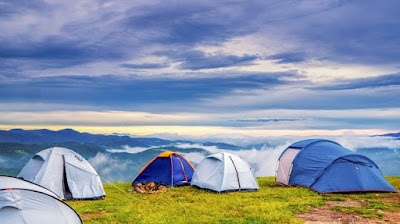Shopping for a tent is like shopping for a home in the outdoors. It’s not enough to just pick anything from the store since different styles, designs, sizes, and other features exist. If you’re just about to get a new one to bring to your adventures, here’s a simple guide that will help you buy the right tent!
How Big and Heavy Should it Be?
Always choose a model based on your group size and the number of items you will bring. If you are car camping, buy a very giant tent. And for backpacking, a tent that’s one person bigger is recommended. So, if there’s just you and your partner in the tent, a 3-person tent is just right.
Remember that the sleeping capacity not only includes who will sleep in a tent but also what kinds of items they have. You also need to consider if you have companions who toss and turn at night, are claustrophobic, are bringing a dog, etc.
For large groups, the WagonTop 8 Tent from Nemo is a great choice. It has is basically a four-person tent with a massive living area that can sleep another four.
Of course, if you’ll be huffing a tent on your back, you need a tent that is made of lightweight materials. Does it fit in your backpack? Can it easily be strapped on it?
What about the Seasonality?
It’s important to know the kind of weather you’ll be camping in. since you’re most likely to reuse the tent, a 4-season tent is highly recommended. This type of tent can withstand strong winds, snow loads, and other conditions. They can stand firm in the face of inhospitable weather and they usually use more poles and heavier fabrics. Their rounded dome designs eliminate flat roof spaces where snow can collect. They offer few mesh panels and rain flies that extend close to the ground to keep the inside warm.
3-season tents, on the other hand, are by far the most popular. They are lightweight shelters for ordinary seasons like spring, summer, and fall. This kind of tent is usually equipped with ample mesh panels for airflow and for keeping insects out. They can also withstand downpours but are not the best choice for sustained exposure to harsh elements.
For rainproof coverage, the Marmot Limestone 6 features a massive fly to cover it all to the ground.
What’s the Intended Use of Your Tent?
Be honest with yourself. Should you really be spending extra bucks on an ultra-lightweight tent or will you be able to sacrifice something a little heavier since you’ll just stay overnight and don’t have a lot of other things to bring? Will you have time to go backpacking, or should you just buy a simple car-camping tent?
For basic backpacking, we love the Big Agnes Tiger Wall! This tent uses thin fabrics and DAC Featherlite poles to make a two-person backpacking tent that actually has room inside for two people, and weighs just over 2 pounds. There’s also a carbon and Dyneema version priced a bit higher weighing 1 pound 6 ounces.
Other Features to Consider
Here are other key tent features you need to consider:
- Height
- Floor length
- Tent doors
- Tent poles
- Rainfly
- Vestibules
- Ventilation
These features, on the other hand, are optional:
- Footprint
- Gear loft
- Stakes and anchors
- Broom and dustpan
- Tent repair kit
- Seam sealer
- Utility cord
More Tips!
Here are more tips you should do to get the perfect tent for your camping trip:
- Rent one before buying. Most outdoor shops offer outdoor gear rent, so you can try different brands to discover which one is the most suitable for you.
- Test your tent in the backyard. Can you set it up? Are the poles easy to use?
- What about alternatives? Have you considered using bivies, tarps, and hammocks?
Learn More:

No comments:
Post a Comment